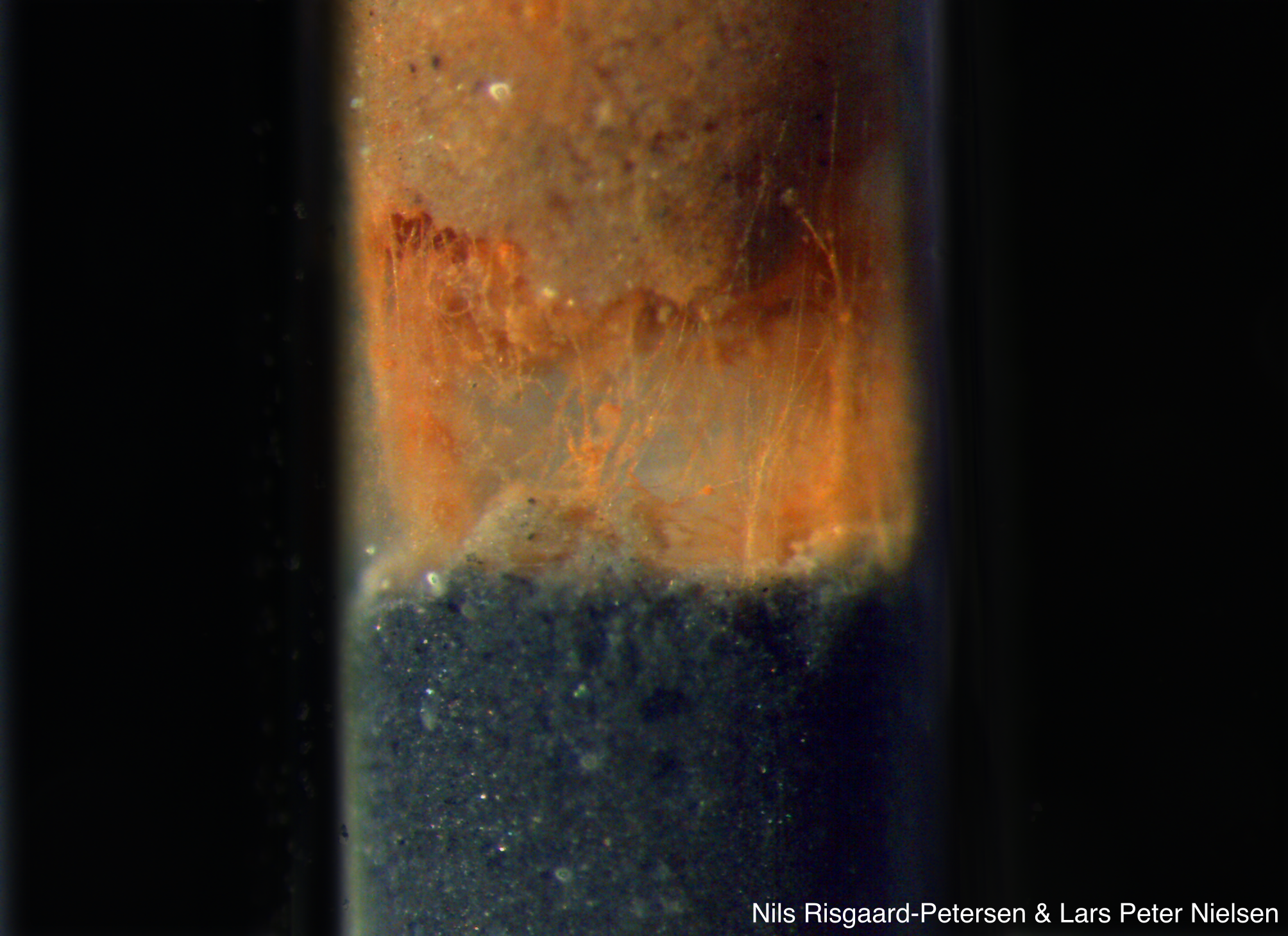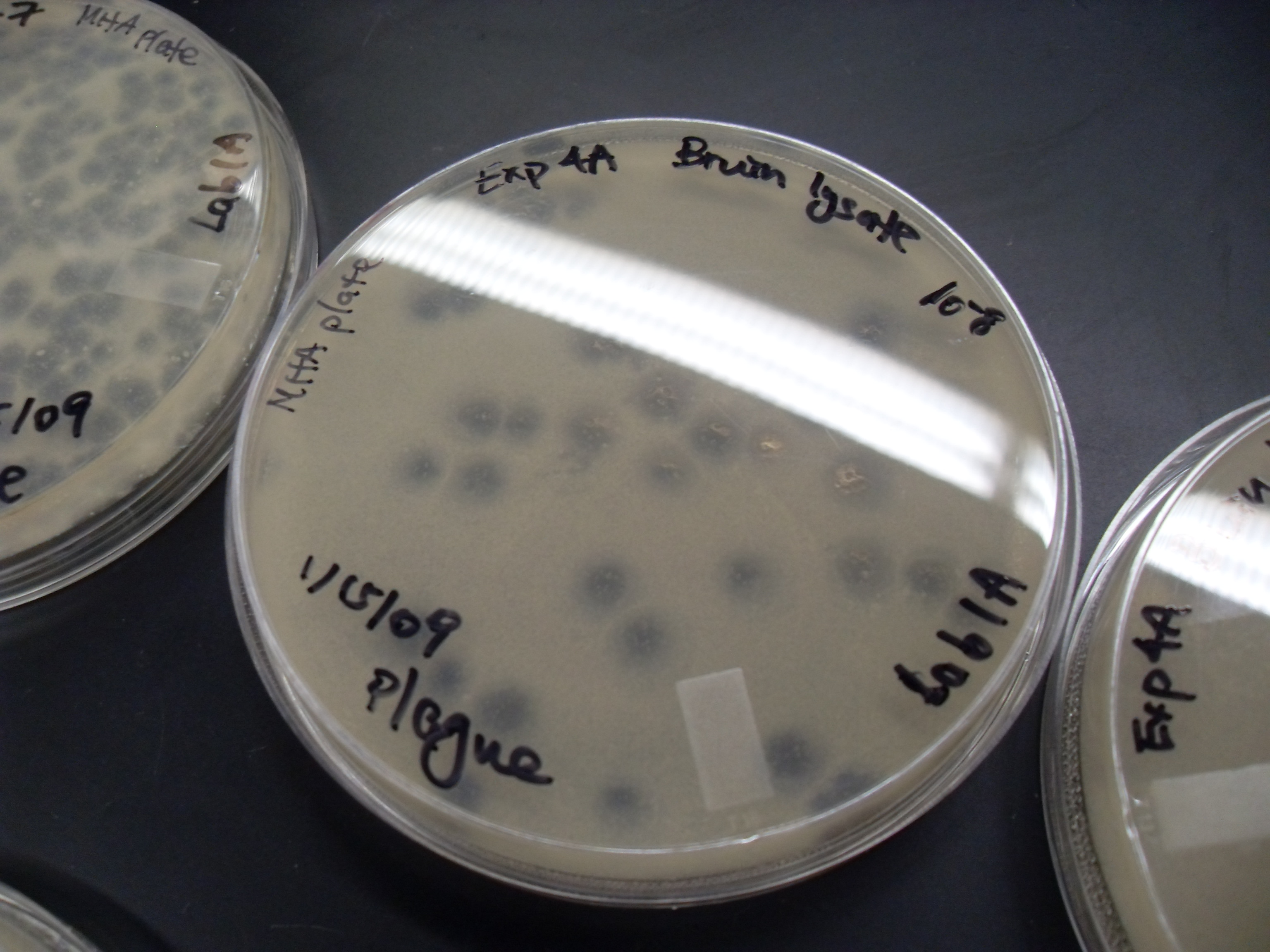|
Electric Bacteria
Electric bacteria are forms of exoelectrogenic bacteria that directly consume and excrete electrons at different energy potentials without requiring the metabolization of any sugars or other nutrients. This form of life appears to be especially adapted to low-oxygen environments. Many life forms require an oxygen environment in which to release the excess of electrons which are produced in metabolizing sugars. In a low oxygen environment, this pathway for releasing electrons is not available. Instead, electric bacteria "breathe" metals instead of oxygen, which effectively results in both an intake of and excretion of electrical charges. Some electric bacteria: * ''Shewanella'', which makes protein nanowires * ''Geobacter'', which makes protein nanowires out of pilin * '' Methanobacterium palustre'' * ''Methanococcus maripaludis'' * ''Mycobacterium smegmatis'' * Modified ''Escherichia coli'' (with ''Geobacter'' nanowire genes) * A broad collection of 30 bacteria varieties from m ... [...More Info...] [...Related Items...] OR: [Wikipedia] [Google] [Baidu] |
Exoelectrogen
An exoelectrogen normally refers to a microorganism that has the ability to transfer electrons extracellularly. While exoelectrogen is the predominant name, other terms have been used: electrochemically active bacteria, anode respiring bacteria, and electricigens. Electrons exocytosed in this fashion are produced following ATP production using an electron transport chain (ETC) during oxidative phosphorylation. Conventional cellular respiration requires a final electron acceptor to receive these electrons. Cells that use molecular oxygen (O2) as their final electron acceptor are described as using aerobic respiration, while cells that use other soluble compounds as their final electron acceptor are described as using anaerobic respiration. However, the final electron acceptor of an exoelectrogen is found extracellularly and can be a strong oxidizing agent in aqueous solution or a solid conductor/electron acceptor. Two commonly observed acceptors are iron compounds (specifically Fe(II ... [...More Info...] [...Related Items...] OR: [Wikipedia] [Google] [Baidu] |
Pilin
Pilin refers to a class of fibrous proteins that are found in pilus structures in bacteria. These structures can be used for the exchange of genetic material, or as a cell adhesion mechanism. Although not all bacteria have pili or fimbriae, bacterial pathogens often use their fimbriae to attach to host cells. In Gram-negative bacteria, where pili are more common, individual pilin molecules are linked by noncovalent protein-protein interactions, while Gram-positive bacteria often have polymerized LPXTG pilin. Type IV pilin Type IV pilin proteins are α+β proteins characterized by a very long N-terminal alpha helix. The assembly of these pili relies on interactions between the N-terminal helices of the individual monomers. The pilus structure sequesters the helices in the center of the fiber lining a central pore, while antiparallel beta sheets occupy the exterior of the fiber. Role of ComP pilin in bacterial transformation Genetic transformation is the process by whic ... [...More Info...] [...Related Items...] OR: [Wikipedia] [Google] [Baidu] |
Electron Transfer
Electron transfer (ET) occurs when an electron relocates from an atom, ion, or molecule, to another such chemical entity. ET describes the mechanism by which electrons are transferred in redox reactions. Electrochemical processes are ET reactions. ET reactions are relevant to photosynthesis and respiration and commonly involve transition metal complexes. In organic chemistry ET is a step in some industrial polymerization reactions. It is foundational to photoredox catalysis. Classes of electron transfer Inner-sphere electron transfer In inner-sphere ET, two redox centers are covalently linked during the ET. This bridge can be permanent, in which case the electron transfer event is termed intramolecular electron transfer. More commonly, however, the covalent linkage is transitory, forming just prior to the ET and then disconnecting following the ET event. In such cases, the electron transfer is termed intermolecular electron transfer. A famous example of an inner sphere ET pr ... [...More Info...] [...Related Items...] OR: [Wikipedia] [Google] [Baidu] |
Cable Bacteria
Cable bacteria are filamentous bacteria that conduct electricity across distances over 1 cm in sediment and groundwater aquifers. Cable bacteria allow for long-distance electron transport, which connects electron donors to electron acceptors, connecting previously separated oxidation and reduction reactions. Cable bacteria couple the reduction of oxygen or nitrate at the sediment's surface to the oxidation of sulfide in the deeper, anoxic, sediment layers. Discovery Long-distance electrical conductance in sediment was first observed in 2010 as a spatial separation of sulfide oxidation and oxygen reduction in marine sediment that was interrupted and re-established at a rate faster than could be explained by chemical diffusion. It was later found that this electrical conductance could be observed across a non-conductive layer of glass microspheres, where the only possible conductive structures were filamentous bacteria belonging to the family Desulfobulbaceae. The conductivi ... [...More Info...] [...Related Items...] OR: [Wikipedia] [Google] [Baidu] |
Quanta Magazine
''Quanta Magazine'' is an editorially independent online publication of the Simons Foundation covering developments in physics, mathematics, biology and computer science. History ''Quanta Magazine'' was initially launched as ''Simons Science News'' in October 2012, but it was renamed to its current title in July 2013. It was founded by the former ''New York Times'' journalist Thomas Lin, who was the magazine's editor-in-chief until 2024. The two deputy editors are John Rennie and Michael Moyer, formerly of ''Scientific American'', and the art director is Samuel Velasco. In 2024, Samir Patel became the magazine's second editor in chief. Content The articles in the magazine are freely available to read online. ''Scientific American'', ''Wired'', ''The Atlantic'', and ''The Washington Post'', as well as international science publications like '' Spektrum der Wissenschaft'', have reprinted articles from the magazine. In November 2018, MIT Press The MIT Press is the uni ... [...More Info...] [...Related Items...] OR: [Wikipedia] [Google] [Baidu] |
Escherichia Coli
''Escherichia coli'' ( )Wells, J. C. (2000) Longman Pronunciation Dictionary. Harlow ngland Pearson Education Ltd. is a gram-negative, facultative anaerobic, rod-shaped, coliform bacterium of the genus '' Escherichia'' that is commonly found in the lower intestine of warm-blooded organisms. Most ''E. coli'' strains are part of the normal microbiota of the gut, where they constitute about 0.1%, along with other facultative anaerobes. These bacteria are mostly harmless or even beneficial to humans. For example, some strains of ''E. coli'' benefit their hosts by producing vitamin K2 or by preventing the colonization of the intestine by harmful pathogenic bacteria. These mutually beneficial relationships between ''E. coli'' and humans are a type of mutualistic biological relationship—where both the humans and the ''E. coli'' are benefitting each other. ''E. coli'' is expelled into the environment within fecal matter. The bacterium grows massi ... [...More Info...] [...Related Items...] OR: [Wikipedia] [Google] [Baidu] |
Mycobacterium Smegmatis
''Mycobacterium smegmatis'' is an acid-fast bacterium, bacterial species in the phylum ''Actinomycetota'' and the genus ''Mycobacterium''. It is 3.0 to 5.0 μm long with a bacillus (shape), bacillus shape and can be stained by Ziehl–Neelsen method and the auramine-rhodamine fluorescent method. It was first reported in November 1884, who found a bacillus with the staining appearance of tubercle bacilli in syphilis, syphilitic chancres. Subsequent to this, Alvarez and Tavel found organisms similar to that described by Lustgarten also in normal genital secretions (smegma). This organism was later named ''M. smegmatis''. Some species of the genus ''Mycobacterium'' have recently been renamed to ''Mycolicibacterium'', so that ''M. smegmatis'' is now ''Mycolicibacterium smegmatis''. ''M. smegmatis'', which was previously considered a nonmotile organism, uses a sliding mechanism that allows it to move around its environment. Henrichsen defines it as, “a kind of surface translo ... [...More Info...] [...Related Items...] OR: [Wikipedia] [Google] [Baidu] |
Methanococcus Maripaludis
''Methanococcus maripaludis'' is a species of methanogenic archaea found in marine environments, predominantly salt marshes. ''M. maripaludis'' is a non-pathogenic, gram-negative, weakly motile, non-spore-forming, and strictly anaerobic mesophile. It is classified as a chemolithoautotroph. This archaeon has a pleomorphic coccoid-rod shape of 1.2 by 1.6 μm, in average size, and has many unique metabolic processes that aid in survival.'''' ''M. maripaludis'' also has a sequenced genome consisting of around 1.7 Mbp with over 1,700 identified protein-coding genes. In ideal conditions, ''M. maripaludis'' grows quickly and can double every two hours. Metabolism The metabolic landscape of ''M. maripaludis'' consists of eight major subsystems which provide pathways for energy generation and cell growth. These subsystems include amino acid metabolism, glycolysis/ glycogen metabolism, methanogenesis, nitrogen metabolism, non-oxidative pentose phosphate pathway (NOPPP), nucleotide me ... [...More Info...] [...Related Items...] OR: [Wikipedia] [Google] [Baidu] |
Methanobacterium Palustre
''Methanobacterium'' is a genus of the ''Methanobacteria'' class in the Archaea kingdom, which produce methane as a metabolic byproduct. Despite the name, this genus belongs not to the bacterial domain but the archaeal domain (for instance, they lack peptidoglycan in their cell walls). ''Methanobacterium'' are nonmotile and live without oxygen, which is toxic to them, and they only inhabit anoxic environments. A shared trait by all methanogens is their ability to recycle products. They can use the products of metabolic activities occurring during methanogenesis as substrates for the formation of methane. ''Methanobacterium'' species typically thrive in environments with optimal growth temperatures ranging from 28 to 40 °C, and in versatile ecological ranges. They are a part of the scientific world that is still relatively unknown, but methanogens are thought to be some of earth's earliest life forms. They do not create endospores when nutrients are limited. They are ubi ... [...More Info...] [...Related Items...] OR: [Wikipedia] [Google] [Baidu] |
Geobacter
''Geobacter'' is a genus of bacteria. ''Geobacter'' species use anaerobic respiration to alter the redox state of minerals and many pollutants, a trait that makes them useful in bioremediation. ''Geobacter'' was the first organism described with the ability to completely oxidize organic compounds to carbon dioxide, and transfer these electrons to metals such as Fe(III), Mn(IV), and U(VI). ''Geobacter'' species are also found to be able to transfer electrons to conductive surfaces such as graphite electrodes. They are found in anaerobic habitats including wetlands, subsurface aquifers, soils, and aquatic sediment. History '' Geobacter metallireducens'' was first isolated by Derek R Lovley in 1987 in sand sediment from the Potomac River in Washington D.C. The first strain was deemed strain GS-15. Phylogeny The currently accepted taxonomy is based on the List of Prokaryotic names with Standing in Nomenclature (LPSN) and National Center for Biotechnology Information (NCBI). ... [...More Info...] [...Related Items...] OR: [Wikipedia] [Google] [Baidu] |
Bacteria
Bacteria (; : bacterium) are ubiquitous, mostly free-living organisms often consisting of one Cell (biology), biological cell. They constitute a large domain (biology), domain of Prokaryote, prokaryotic microorganisms. Typically a few micrometres in length, bacteria were among the first life forms to appear on Earth, and are present in most of its habitats. Bacteria inhabit the air, soil, water, Hot spring, acidic hot springs, radioactive waste, and the deep biosphere of Earth's crust. Bacteria play a vital role in many stages of the nutrient cycle by recycling nutrients and the nitrogen fixation, fixation of nitrogen from the Earth's atmosphere, atmosphere. The nutrient cycle includes the decomposition of cadaver, dead bodies; bacteria are responsible for the putrefaction stage in this process. In the biological communities surrounding hydrothermal vents and cold seeps, extremophile bacteria provide the nutrients needed to sustain life by converting dissolved compounds, suc ... [...More Info...] [...Related Items...] OR: [Wikipedia] [Google] [Baidu] |
Shewanella
''Shewanella'' is the sole genus included in the marine bacteria family Shewanellaceae. Some species within it were formerly classed as '' Alteromonas''. ''Shewanella'' consists of facultatively anaerobic Gram-negative rods, most of which are found in extreme aquatic habitats where the temperature is very low and the pressure is very high. ''Shewanella'' bacteria are a normal component of the surface flora of fish and are implicated in fish spoilage. ''Shewanella chilikensis'', a species of the genus ''Shewanella'' commonly found in the marine sponges of Saint Martin's Island of the Bay of Bengal, Bangladesh. ''Shewanella oneidensis'' MR-1 is a widely used laboratory model to study anaerobic respiration of metals and other anaerobic extracellular electron acceptors, and for teaching about microbial electrogenesis and microbial fuel cells. Biochemical characteristics of ''Shewanella'' species Colony, morphological, physiological, and biochemical characteristics of ''Shewanel ... [...More Info...] [...Related Items...] OR: [Wikipedia] [Google] [Baidu] |





